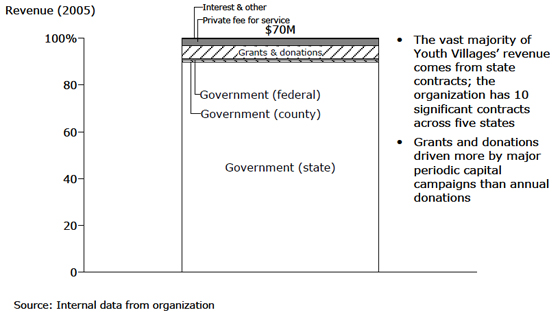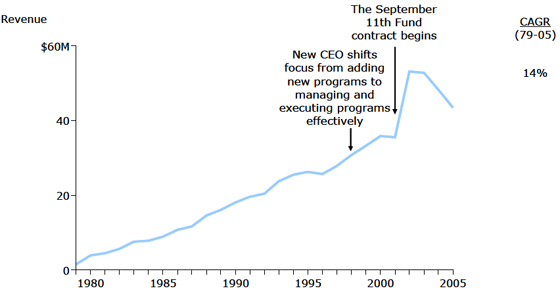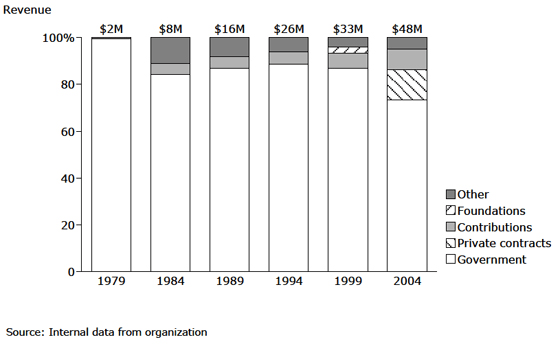We had convinced the state that they shouldn’t be buying beds; they should buy outcomes, successful outcomes.
– Patrick Lawler, Chief Executive Officer
Overview
Related Content
How Nonprofits Get Really BigOrganization Profiles from How Nonprofits Get Really Big
With a mission of helping children and families live successfully, Youth Villages serves youth in or at risk of entering the child welfare and juvenile justice systems. The organization provides residential facilities, foster care services, and in-home services. Its origins trace back to 1979.
In 1994 Youth Villages began emphasizing helping children in the least restrictive, most family-based environment possible. It is the nation’s pioneer and leading provider of multi-systemic therapy (MST) in-home services. Currently working in Tennessee, Alabama, Arkansas, Mississippi, North Carolina, Texas, and Washington D.C., Youth Villages consistently achieves 80% long-term success rates in populations where 30% rates are common.
Youth Villages has been able to achieve significant scale by cultivating diverse sources of state government funding. The organization has developed relationships with multiple departments in multiple states. Its willingness to take on significant risk in its state contracts also has buoyed funding. For example, in its largest contract, Tennessee pays Youth Villages a specific amount per child based on the severity of the child’s situation. The organization then must serve the child for that fee regardless of what degree of service the child ultimately requires.
Founding date: 1979
Revenue (2003): $70 million
Structure: Single organization
NCCS classification: Human services, children, & youth services
Services: Provides residential, foster care, and in-home services designed to support children in the least restrictive environment possible
Beneficiaries: Children who have emotional or behavioral disorders, have suffered physical or sexual abuse, and/or are at risk of substance abuse or suicide
Leadership (selected): Patrick Lawler, Chief Executive Officer; Tim Goldsmith, Chief Clinical Officer; Lee Rone, Chief Operating Officer; Greg Gregory, Chief Financial Officer
Address: P.O. Box 341154, Memphis, TN 38184-1154
Website: www.youthvillages.org

Growth Story
- 1979 – Youth Villages (originally named Dogwood Village) is founded in Tennessee.
- 1984 – At behest of a board member, Youth Villages begins to focus on its financial margins and launches its first capital campaign.
- 1986 – The organization merges with Memphis Boys Town and changes its name to Youth Villages.
- 1991 – Youth Villages acquires land in middle of the state to build a residential facility and become a statewide rather than western Tennessee service provider.
- 1992 – The organization begins a foster care program.
- 1993 – Youth Villages identifies intensive family-based in-home counseling as greatest need in TN after interviewing 126 state officials.
- 1994 – The organization begins in-home services using a multi-systemic therapy (MST) model.
- 1995 – Youth Villages takes an “at-risk contract” with state of Tennessee.
- 1996 – The organization expands its in-home services by opening an office in Jackson, Mississippi.
- 1997 – Youth Villages opens an office in Arkansas, its first outside of Tennessee.
- 2000 – The national coalition for juvenile justice highlights Youth Villages as a national model.
Revenue Trends
Revenue growth: Youth Villages has annual growth rate of over 20% since 1990.

Funding mix: Throughout its history, revenue from state government agencies has fueled Youth Villages’ growth.

Actions That Helped Propel Growth in Funding
- Focused on financial margins. Only after Youth Villages began focusing on margins did major growth occur.
- Diversified within a single type of funding. Youth Villages diversified its funding streams within state government revenue by working with multiple states and multiple departments within each state.
- Realized and tracked superior outcomes. The organization has found its consistent record of superior outcomes to be helpful in securing state contracts.
- Turned moments of crisis into opportunities for expansion. Youth Villages secured its largest contract during a time of financial crisis for Tennessee.
- Took risks. Believing in the power of its program, Youth Villages has been willing to take on risk to open up growth opportunities. It serves the youth no one else is willing to serve, and also has taken on financial risk in its largest contract.
- Provided input and support to states for new program development. Collaborative relationships with state government officials have allowed the organization to participate in the program development process, matching existing best practices with the states’ needs.
- &Used private donations to help build the organization’s capacity. While a small share of revenue today, private donations played a large role early in Youth Villages’ history and continue to help it invest in capacity building.
Funding Challenges
- Dealing with tight financial allowances for state government contracts. Low margin state contracts have made it hard for Youth Villages to fund capacity building. It has designed staff ratios and program offerings to fit within strict financial allowances.
- Raising funds to serve beneficiaries not covered by state government contracts. Since its state contracts only support youth ages 18 and younger, Youth Villages has had to raise private philanthropic dollars to fund transitional services for older youth.
- Satisfying varied reporting requirements by state. The organization had to develop sophisticated financial reporting and data-tracking systems to meet widely ranging state requirements.

